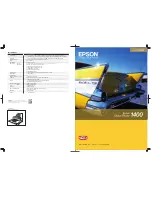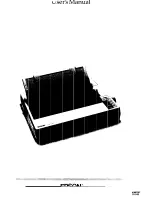
❏
When storing or transporting an ink bottle, do not tilt the bottle and do not subject it to impacts or temperature
changes. Otherwise, ink may leak even if the cap on the ink bottle is tightened securely. Be sure to keep the ink
bottle upright when tightening the cap, and take precautions to prevent ink from leaking when transporting the
bottle, for example, putting the bottle in a bag.
❏
After bringing an ink bottle inside from a cold storage site, allow it to warm up at room temperature for at least
three hours before using it.
❏
Do not open the ink bottle package until you are ready to fill the ink tank. The ink bottle is vacuum packed to
maintain its reliability. If you leave an ink bottle unpacked for a long time before using it, normal printing may
not be possible.
❏
Once you open an ink bottle, we recommend using it as soon as possible.
Handling precautions for refilling ink
❏
To ensure you receive premium print quality and to help protect your print head, a variable ink safety reserve
remains in the ink tank when your printer indicates to refill ink. The yields quoted for you do not include this
reserve.
❏
For optimum print results do not maintain low ink levels for extended periods of time.
❏
Use ink bottles with the correct part code for this printer.
❏
The ink for this printer must be handled carefully. Ink may splatter when the ink tanks are being filled or refilled
with ink. If ink gets on your clothes or belongings, it may not come off.
❏
Do not shake too vigorously or squeeze the ink bottles.
❏
Prolonged use of the printer when the ink level is below the lower line could damage the printer. Fill the ink
tank to the upper line while the printer is not operating. To display the correct ink level estimates, reset the ink
level after filling the tank.
❏
To obtain optimum printing results, refill the ink tanks to the upper line at least once every year.
Ink consumption
❏
To maintain optimum print head performance, some ink is consumed from all ink tanks during maintenance
operations such as print head cleaning. Ink may also be consumed when you turn the printer on.
❏
When printing in monochrome or grayscale, color inks instead of black ink may be used depending on the
paper type or print quality settings. This is because a mixture of color inks is used to create black.
❏
The ink in the ink bottles supplied with your printer is partly used during initial setup. In order to produce high
quality printouts, the print head in your printer will be fully charged with ink. This one-off process consumes a
quantity of ink and therefore these bottles may print fewer pages compared to subsequent ink bottles.
❏
Quoted yields may vary depending on the images that you are printing, the paper type that you are using, the
frequency of your prints and environmental conditions such as temperature.
❏
Visually check ink levels in the actual ink tanks. Prolonged use of the printer when the ink is expended could
damage the printer. Epson recommends filling the ink tank to the upper line when the printer is not operating
to reset the ink level.
Refilling the Ink Tanks
1.
Close the document cover if it is open.
>
>
193
Summary of Contents for EcoTank ET-4856
Page 16: ...Part Names and Functions Part Names and Functions 17 ...
Page 27: ...Loading Paper Paper Handling Precautions 28 Paper Size and Type Settings 28 Loading Paper 30 ...
Page 31: ...Placing Originals Placing Originals 32 Originals that are not Supported by the ADF 33 ...
Page 300: ...Where to Get Help Technical Support Web Site 301 Contacting Epson Support 301 ...
















































